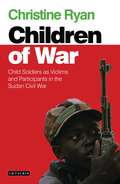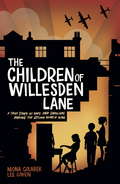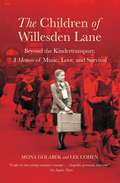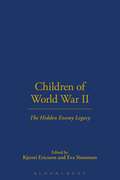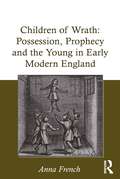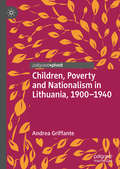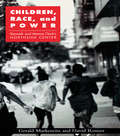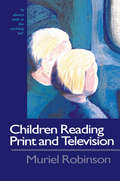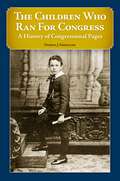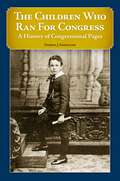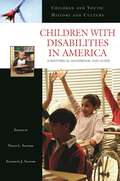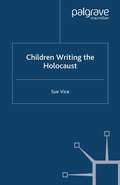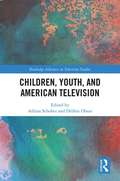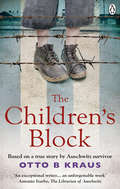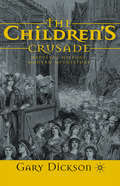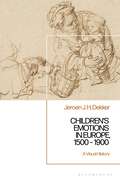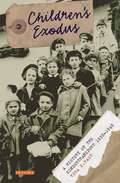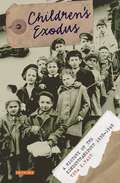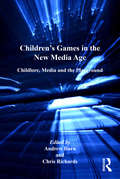- Table View
- List View
Children of War: Child Soldiers as Victims and Participants in the Sudan Civil War (International Library Of African Studies)
by Christine RyanThe use of child soldiers in the Sudan Civil War has shattered the accepted understanding of why children join armies. Thousands of children signed up to participate in Africa's longest running civil war, yet so far the international community and the academic world have viewed them as victims rather than participants. In this groundbreaking new study, Christine EmilyRyan challenges preconceptions which have held back aid work and reconstruction in the Sudan region.Using face-to-face testimonies of former child soldiers, Ryan illuminates the multi-dimensional motivations which children have for joining the Sudan People's Liberation Army, and unravels the complexity of their political participation. At the same time, interviews withNGO personnel illustrate the gap that exists between the West and the reality of conflict in Africa. With over 100 interviews with former child soldiers and NGO workers, and based on extensive and independent fieldwork in Sudan itself, Children of War posits a new way of approaching both the concept of the child in conflict zones, and empowers the child soldiers themselves as actors and participants in history.Children of War provides a powerful critique of the position taken by the international community, NGOs and academia to the phenomenon of child soldiers, and calls for a new approach to conflict resolution in Africa.
The Children of Willesden Lane: Beyond The Kindertransport - A Memoir Of Music, Love And Survival
by Mona Golabek Lee CohenFourteen-year-old Lisa Jura was a musical prodigy who hoped to become a concert pianist. But when Hitler's armies advanced on pre-war Vienna, Lisa's parents were forced to make a difficult decision. Able to secure passage for only one of their three daughters through the Kindertransport, they chose to send gifted Lisa to London for safety. As she yearned to be reunited with her family while she lived in a home for refugee children on Willesden Lane, Lisa's music became a beacon of hope. A memoir of courage, survival, and the power of music to uplift the human spirit, this compelling tribute to one special young woman and the lives she touched will both educate and inspire young readers. Based on a true story of a 14 year old girl Lisa Jura, who had to flee her home in Vienna and rebuild her life in London, the story brings home the reality of the Holocaust to readers aged 12 and up.
The Children of Willesden Lane: Beyond the Kindertransport: A Memoir of Music, Love, and Survival
by Mona Golabek Lee CohenBased on the true story of her mother, Mona Golabek describes the inspirational story of Lisa Jura's escape from Nazi-controlled Austria to England on the famed Kindertransport. Jewish musical prodigy Lisa Jura has a wonderful life in Vienna. But when the Nazis start closing in on the city, life changes irreversibly. Although he has three daughters, Lisa's father is only able to secure one berth on the Kindertransport. The family decides to send Lisa to London so that she may pursue her dreams of a career as a concert pianist. Separated from her beloved family, Lisa bravely endures the trip and a disastrous posting outside London before finding her way to the Willesden Lane Orphanage. It is in this orphanage that Lisa's story truly comes to life. Her music inspires the other orphanage children, and they, in turn, cheer her on in her efforts to make good on her promise to her family to realize her musical potential. Through hard work and sheer pluck, Lisa wins a scholarship to study piano at the Royal Academy. As she supports herself and studies, she makes a new life for herself and dreams of reconnecting with the family she was forced to leave behind. The resulting tale delivers a message of the power of music to uplift the human spirit and to grant the individual soul endurance, patience, and peace.
Children of World War II: The Hidden Enemy Legacy
by Kjersti Ericsson Eva SimonsenThere is a hidden legacy of war that is rarely talked about: the children of native civilians and enemy soldiers. What is their fate?This book unearths the history of the thousands of forgotten children of World War II, including its prelude and aftermath during the Spanish Civil War and the Allied occupation of Germany. It looks at liaisons between German soldiers and civilian women in the occupied territories, and the Nazi Lebensborn program of racial hygiene. It also considers the children of African-American soldiers and German women. The authors examine what happened when the foreign solders went home and discuss the policies adopted towards these children by the Nazi authorities as well as postwar national governments. Personal testimonies from the children themselves reveal the continued pain and shame of being children of the enemy.Case studies are taken from France, Germany, the Netherlands, Czechoslovakia, Norway, Denmark and Spain.
Children of Wrath: Possession Prophecy And The Young In Early Modern England
by Anna FrenchThe spiritual status of the early modern child was often confused and uncertain, and yet in the wake of the English Reformation became an issue of urgent interest. This book explores questions surrounding early modern childhood, focusing especially on some of the extreme religious experiences in which children are documented: those of demonic possession and godly prophecy. Dr French argues that despite the fact that these occurrences were not typical childhood experiences, they provide us with a window through which to glimpse the world of early modern children. The work introduces its readers to the dualistic nature of early modern perceptions of their young - they were seen to be both close to devilish temptations and to God’s divine finger, as illustrated by published accounts of possession and prophecy. These cases reveal to us moments in which children could be granted authority or in which writers and publishers framed children in positions of spiritual agency. This can tell us much about how early modern society perceived, imagined and depicted their young, and helps us to revise the notion that early modern children’s lives, which were often fleeting, may have gone unregarded. Both contributing to, and informed by, some of the most recent historiographical directions taken by early modern history, this book engages with three key areas: the history of extreme spiritual experience such as demonic possession, the ’lived experience’ of early modern religion and the history of childhood. In this way, it offers the first scholarly exploration of the dialogue between these three areas of current and widespread historical interest which have, perhaps surprisingly, not yet been considered together.
Children of Wrath: Possession, Prophecy and the Young in Early Modern England
by Anna FrenchThe spiritual status of the early modern child was often confused and uncertain, and yet in the wake of the English Reformation became an issue of urgent interest. This book explores questions surrounding early modern childhood, focusing especially on some of the extreme religious experiences in which children are documented: those of demonic possession and godly prophecy. Dr French argues that despite the fact that these occurrences were not typical childhood experiences, they provide us with a window through which to glimpse the world of early modern children. The work introduces its readers to the dualistic nature of early modern perceptions of their young - they were seen to be both close to devilish temptations and to God’s divine finger, as illustrated by published accounts of possession and prophecy. These cases reveal to us moments in which children could be granted authority or in which writers and publishers framed children in positions of spiritual agency. This can tell us much about how early modern society perceived, imagined and depicted their young, and helps us to revise the notion that early modern children’s lives, which were often fleeting, may have gone unregarded. Both contributing to, and informed by, some of the most recent historiographical directions taken by early modern history, this book engages with three key areas: the history of extreme spiritual experience such as demonic possession, the ’lived experience’ of early modern religion and the history of childhood. In this way, it offers the first scholarly exploration of the dialogue between these three areas of current and widespread historical interest which have, perhaps surprisingly, not yet been considered together.
Children, Poverty and Nationalism in Lithuania, 1900–1940
by Andrea GriffanteThis book discusses the emergence of care for orphaned, abandoned and poor children in Lithuania from the early twentieth century to the beginning of the Second World War. In particular, it focuses on how such practices were influenced by nationalist and political discourses, and how orphanages became privileged institutions for nation building. Emerging during the humanitarian crisis following the First World War, the Lithuanian orphaned and destitute children’s assistance network had an eminently ethno-national character, and existed in parallel with, and was challenged by, Polish poor child assistance institutions. By analysing such care for children, this book explores concepts such as the nation state and citizenship, as well as the connections between poverty, childhood and nationalism.
Children, Race, and Power: Kenneth and Mamie Clark's Northside Center
by Gerald Markowitz David RosnerA portrait of two important black social scientists and a broader history of race relations, this important work captures the vitality and chaos of post-war politics in New York, recasting the story of the civil rights movement.
Children, Race, and Power: Kenneth and Mamie Clark's Northside Center
by Gerald Markowitz David RosnerA portrait of two important black social scientists and a broader history of race relations, this important work captures the vitality and chaos of post-war politics in New York, recasting the story of the civil rights movement.
Children Reading Print and Television Narrative: It Always Ends At The Exciting Bit
by Dr Muriel Robinson Muriel RobinsonContrary to the popular assumption that television viewing is a very different process from book reading and inhibits reading in a variety of ways, the author argues that in fact the two activities can be mutually supportive and involve many of the same strategies. It may have implications for teachers as the book offers a research-based view and calls for a new emphasis in school practice which will include television as text and which supports children's developing abilities to make meaning from a range of texts. The author highlights the need for teachers to consider television in the same way as print media.
Children Reading Print and Television Narrative: It Always Ends At The Exciting Bit
by Dr Muriel Robinson Muriel RobinsonContrary to the popular assumption that television viewing is a very different process from book reading and inhibits reading in a variety of ways, the author argues that in fact the two activities can be mutually supportive and involve many of the same strategies. It may have implications for teachers as the book offers a research-based view and calls for a new emphasis in school practice which will include television as text and which supports children's developing abilities to make meaning from a range of texts. The author highlights the need for teachers to consider television in the same way as print media.
The Children Who Ran for Congress: A History of Congressional Pages
by Darryl J. GonzalezThis book offers a meticulously researched, comprehensive chronology of the Congressional Page system, from the late 1700s to modern day.From the origins of the page system in 1774 to the period in the 1940s when Congress demonstrated an indifference towards the needs of providing the boys with supervised living arrangements, congressional pages have a storied past. It's a topic that can be amusing—for years, pages simply treated the Capitol as a their private playground to subject adults to their mischief—and sobering, as Congress continued to employ boys as young as eight years old, even after passing labor laws that prohibited it and was reluctant to provide supervised living arrangements for decades.Unlike many dry and lifeless books about Congressional history, The Children Who Ran For Congress: A History of Congressional Pages provides a lively and engaging look at the history of the page system, a topic that has largely been ignored. Based on a thorough investigation of historical documents and personal interviews, Darryl Gonzalez now tells the complete story of the young boys (and girls) who have served Congress for more than 200 years.
The Children Who Ran for Congress: A History of Congressional Pages
by Darryl J. GonzalezThis book offers a meticulously researched, comprehensive chronology of the Congressional Page system, from the late 1700s to modern day.From the origins of the page system in 1774 to the period in the 1940s when Congress demonstrated an indifference towards the needs of providing the boys with supervised living arrangements, congressional pages have a storied past. It's a topic that can be amusing—for years, pages simply treated the Capitol as a their private playground to subject adults to their mischief—and sobering, as Congress continued to employ boys as young as eight years old, even after passing labor laws that prohibited it and was reluctant to provide supervised living arrangements for decades.Unlike many dry and lifeless books about Congressional history, The Children Who Ran For Congress: A History of Congressional Pages provides a lively and engaging look at the history of the page system, a topic that has largely been ignored. Based on a thorough investigation of historical documents and personal interviews, Darryl Gonzalez now tells the complete story of the young boys (and girls) who have served Congress for more than 200 years.
Children with Disabilities in America: A Historical Handbook and Guide (Children and Youth: History and Culture)
by Philip L. Safford Elizabeth J. SaffordImages of disabled children are found throughout well-known works of literature, film, and even opera. Their characters range from sweet, to brave, to tragic. Disabled children are also a part of the reality of life either in personal ways or as poster girls and boys for drives and causes. Behind these images is a historical presence that has been created by the societies in which these children live and have lived. This work examines current knowledge about children's experience of physical, cognitive, and emotional/behavioral impairments from the Colonial period to the present, while revealing the social constructions of both disability and childhood throughout American history.Just as disability has been advanced as an essential consideration in other historical inquiries, such as that of gender, this is a work intended to demonstrate the critical role of disability with respect to the history of childhood.
Children Writing the Holocaust
by S. ViceThis book examines a wide range of works written by and about child survivors and victims of the Holocaust. The writers analyzed range from Anne Frank and Saul Friedlander to Ida Fink and Louis Begley; topics covered include the Kindertransport experience, exile to Siberia, living in hiding, Jewish children masquerading as Christian, and ghetto diaries. Throughout, the argument is made that these texts use such similar techniques and structures that children's-eye views of the Holocaust constitute a discrete literary genre.
Children, Youth, and American Television (Routledge Advances in Television Studies)
by Adrian Schober Debbie OlsonThis volume explores how television has been a significant conduit for the changing ideas about children and childhood in the United States. Each chapter connects relevant events, attitudes, or anxieties in American culture to an analysis of children or childhood in select American television programs. The essays in this collection explore historical intersections of the family with expectations of childhood, particularly innocence, economic and material conditions, and emerging political and social realities that, at times, present unique challenges to America’s children and the collective expectation of what childhood should be.
Children, Youth, and American Television (Routledge Advances in Television Studies)
by Adrian Schober Debbie OlsonThis volume explores how television has been a significant conduit for the changing ideas about children and childhood in the United States. Each chapter connects relevant events, attitudes, or anxieties in American culture to an analysis of children or childhood in select American television programs. The essays in this collection explore historical intersections of the family with expectations of childhood, particularly innocence, economic and material conditions, and emerging political and social realities that, at times, present unique challenges to America’s children and the collective expectation of what childhood should be.
The Children's Block: Based on a true story by an Auschwitz survivor
by Otto B Kraus'We lived on a bunk built for four but in times of overcrowding, it slept seven and at times even eight. There was so little space on the berth that when one of us wanted to ease his hip, we all had to turn in a tangle of legs and chests and hollow bellies as if we were one many-limbed creature, a Hindu god or a centipede. We grow intimate not only in body but also in mind because we knew that though we were not born of one womb, we would certainly die together.'Alex Ehren is a poet, a prisoner and a teacher in block 31 in Auschwitz-Birkenau, the children’s block. He spends his days trying to survive while illegally giving lessons to his young charges while shielding them as best he can from the impossible horrors of the camp. But trying to teach the children is not the only illicit activity that Alex is involved in. Alex is keeping a diary…Originally published as THE PAINTED WALL, Otto Kraus’s autobiographical novel, tells the true story of 500 Jewish children who lived in the Czech Family Camp in Auschwitz-Birkenau between September 1943 and June 1944.
The Children's Crusade: Medieval History, Modern Mythistory
by G. DicksonThe Children's Crusade was possibly the most extraordinary event in the history of the crusades. The first modern study in English of this popular crusade sheds new light on its history and offers new perspectives on its supposedly dismal outcome. Its richly re-imagined history and mythistory is explored from the thirteenth century to present day.
Children’s Emotions in Europe, 1500 – 1900: A Visual History
by Professor Jeroen J. DekkerThis book gives you the historical sensation of coming face to face with the bodily expression and regulation of children's emotions over time. The study does this by encouraging you to look through the eyes of well-known artists, like Albrecht Dürer, Domenico Ghirlandaio, Jan Steen, Antony van Dyck, Rembrandt, and Titian in early modern Europe, and Jean-Baptiste Siméon Chardin, Thomas Lawrence,Jean-Honoré Fragonard, Philipp Otto Runge, Willem Bartel van der Kooi, Paul Gauguin, Auguste Renoir, and Jozef Israëls in the late 18th and 19th centuries. These sources are supplemented by works from less-famous artists, as well as popular emblem books, child-advice manuals, observations from the emerging child sciences, and personal documents. Jeroen Dekker observes children's emotions mainly in the child's world and in the domestic emotional space, and connects them with history's ongoing, underlying discourse on education and the emotions. This discourse was developed by theologians, philosophers, and moralists like Augustine, Aquinas, Erasmus, Descartes, Jacob Cats, John Locke and Jean-Jacques Rousseau, by Romantic educationalists like Friedrich Fröbel and Ellen Key, and by scientists like Charles Darwin and William James who emphasized the biological instead of the moral fundament of children's emotions. The story of children's emotions is told in the context of cultural movements like the Renaissance, Humanism, the Reformation, the Enlightenment, Romanticism, and the starting Age of Child Science. Children's Emotions in Europe, 1500 – 1900 crucially highlights the continuous co-existence of regulation-oriented and child-oriented educational views on children's emotions.
Children’s Emotions in Europe, 1500 – 1900: A Visual History
by Professor Jeroen J. DekkerThis book gives you the historical sensation of coming face to face with the bodily expression and regulation of children's emotions over time. The study does this by encouraging you to look through the eyes of well-known artists, like Albrecht Dürer, Domenico Ghirlandaio, Jan Steen, Antony van Dyck, Rembrandt, and Titian in early modern Europe, and Jean-Baptiste Siméon Chardin, Thomas Lawrence,Jean-Honoré Fragonard, Philipp Otto Runge, Willem Bartel van der Kooi, Paul Gauguin, Auguste Renoir, and Jozef Israëls in the late 18th and 19th centuries. These sources are supplemented by works from less-famous artists, as well as popular emblem books, child-advice manuals, observations from the emerging child sciences, and personal documents. Jeroen Dekker observes children's emotions mainly in the child's world and in the domestic emotional space, and connects them with history's ongoing, underlying discourse on education and the emotions. This discourse was developed by theologians, philosophers, and moralists like Augustine, Aquinas, Erasmus, Descartes, Jacob Cats, John Locke and Jean-Jacques Rousseau, by Romantic educationalists like Friedrich Fröbel and Ellen Key, and by scientists like Charles Darwin and William James who emphasized the biological instead of the moral fundament of children's emotions. The story of children's emotions is told in the context of cultural movements like the Renaissance, Humanism, the Reformation, the Enlightenment, Romanticism, and the starting Age of Child Science. Children's Emotions in Europe, 1500 – 1900 crucially highlights the continuous co-existence of regulation-oriented and child-oriented educational views on children's emotions.
Children's Exodus: A History of the Kindertransport
by Vera K. FastIn the months leading up to the outbreak of World War Two, Britain rushed to evacuate nearly 10,000 Jewish children from the Nazi occupied territories. Through the unprecedented cooperation of religious and governmental organizations, the Kindertransport spared thousands of Jewish children from the terror of the Third Reich and provided them with host families in Britain. "Children's Exodus" offers an in-depth look at the people and politics behind the various chains of rescue as well as the personal narratives of the children who left everything behind in the hope of finding safety. Drawing on unpublished interviews, journals, and articles, Vera K. Fast examines the religious and political tensions that emerged throughout the migration and at times threatened to bring operations to a halt. "Children's Exodus" captures the life-affirming stories of child refugees with vivid detail and examines the motivations - religious or otherwise - of the people that orchestrated one of the greatest rescue missions of all time.
Children's Exodus: A History of the Kindertransport
by Vera K. FastAs the Holocaust loomed on the horizon, Britain rushed to evacuate nearly 10,000 Jewish children from the Nazi occupied territories in the months leading up to the outbreak of the Second World War. Through the unprecedented cooperation of religious and governmental organizations, the Kindertransport spared these children from the terror of the Third Reich and provided them with host families throughout Britain. 'Children's Exodus' offers an in-depth look at the people and politics behind the various chains of rescue as well as the personal narratives of the children who left everything behind in hopes of finding safety. For the children who faced prosecution at the hands of the Nazis, the road to England took many forms. Vera K. Fast's account includes a diverse array of narratives which offer inspiring tales of endurance and survival in the face of extermination. Separated from their heritage and history, child refugees were forced to look inward for answers to lingering questions about their own religious identity as they struggled to adapt to their foreign surroundings. Drawing on unpublished interviews, journals, and articles, author Vera K. Fast examines the religious and political tensions that emerged throughout the migration and at times threatened to bring operations to a halt. 'Children's Exodus' explores the aftermath of the Refugee Children Movement as well as the subsequent attempts to reunite the fragmented Jewish community. The recently released records of Rabbi Schonfeld provide rare insight into the Othodox Jewish response to the Kindertransport movement. His papers document the search for the thousands of 'hidden Jews' who remained scattered throughout Europe in the years following the war as well as his controversial methods for bringing them to England. The book also provides a unique assessment of the second wave of the Kindertransport, which took place in 1945, to rescue the young survivors of the Holocaust.Vera K. Fast captures the life-affirming stories of child refugees with vivid detail and examines the motivations - religious or otherwise - of the organizations that orchestrated one of the greatest rescue missions of all time.
Children's Games in the New Media Age: Childlore, Media and the Playground (Studies in Childhood, 1700 to the Present)
by Andrew Burn Chris RichardsThe result of a unique research project exploring the relationship between children's vernacular play cultures and their media-based play, this collection challenges two popular misconceptions about children's play: that it is depleted or even dying out and that it is threatened by contemporary media such as television and computer games. A key element in the research was the digitization and analysis of Iona and Peter Opie's sound recordings of children's playground and street games from the 1970s and 1980s. This framed and enabled the research team's studies both of the Opies' documents of mid-twentieth-century play culture and, through a two-year ethnographic study of play and games in two primary school playgrounds, contemporary children's play cultures. In addition the research included the use of a prototype computer game to capture playground games and the making of a documentary film. Drawing on this extraordinary data set, the volume poses three questions: What do these hitherto unseen sources reveal about the games, songs and rhymes the Opies and others collected in the mid-twentieth century? What has happened to these vernacular forms? How are the forms of vernacular play that are transmitted in playgrounds, homes and streets transfigured in the new media age? In addressing these questions, the contributors reflect on the changing face of childhood in the twenty-first century - in relation to questions of gender and power and with attention to the children's own participation in producing the ethnographic record of their lives.
Children's Games in the New Media Age: Childlore, Media and the Playground (Studies in Childhood, 1700 to the Present)
by Andrew Burn Chris RichardsThe result of a unique research project exploring the relationship between children's vernacular play cultures and their media-based play, this collection challenges two popular misconceptions about children's play: that it is depleted or even dying out and that it is threatened by contemporary media such as television and computer games. A key element in the research was the digitization and analysis of Iona and Peter Opie's sound recordings of children's playground and street games from the 1970s and 1980s. This framed and enabled the research team's studies both of the Opies' documents of mid-twentieth-century play culture and, through a two-year ethnographic study of play and games in two primary school playgrounds, contemporary children's play cultures. In addition the research included the use of a prototype computer game to capture playground games and the making of a documentary film. Drawing on this extraordinary data set, the volume poses three questions: What do these hitherto unseen sources reveal about the games, songs and rhymes the Opies and others collected in the mid-twentieth century? What has happened to these vernacular forms? How are the forms of vernacular play that are transmitted in playgrounds, homes and streets transfigured in the new media age? In addressing these questions, the contributors reflect on the changing face of childhood in the twenty-first century - in relation to questions of gender and power and with attention to the children's own participation in producing the ethnographic record of their lives.
